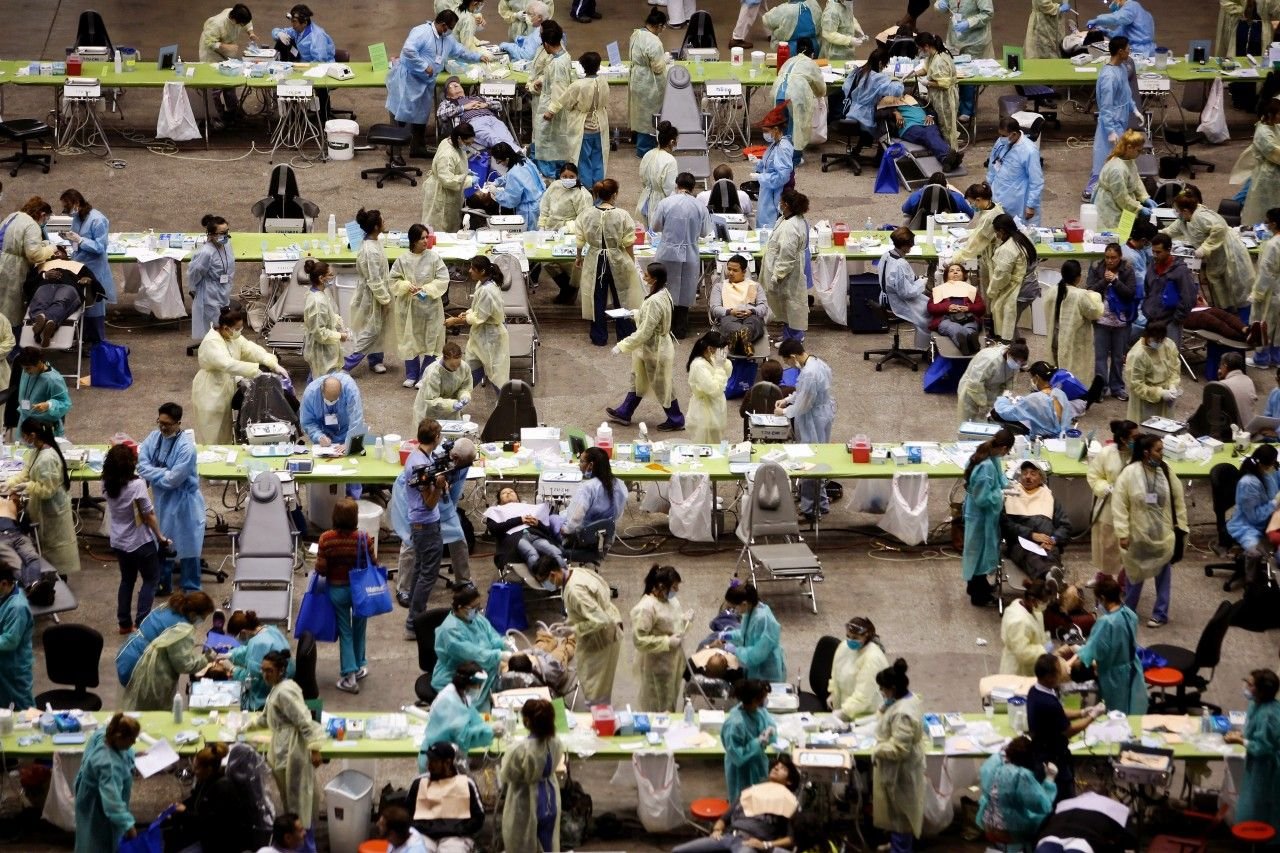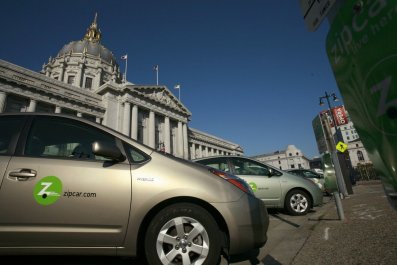If Obamacare gets blown up by Congress later this year, you might want to thank (or blame, depending on your prejudices regarding the Affordable Care Act) the state of Vermont. If it can't make it there, some argue, it can't make it anywhere.
On a warm day last July, a small group of Vermont state employees gathered eagerly in a conference room in Winooski, Vt., to witness a milestone: the first demonstration of their state's new health insurance exchange under President Obama's historic health insurance plan. As Melissa Boudreault, a vice president at CGI Technologies and Solutions, the technology company building the website, and state staffers kicked off the event, the folks from Vermont felt a mix of apprehension and hope. Was VermontHealthConnect, the complex website CGI had been racing to build over the previous seven months, a major step closer to meeting its October 1 deadline?
They knew what they'd be seeing was "not a finished product," according to slides prepared for the event by CGI and the state. Nonetheless, the run-through would, those slides promised, "test operability of all the components" and "provide an early view of functionality" of how consumers would "log in, register and create an application for insurance" come October 1. No, it couldn't yet show live connections with insurance companies - a key step to getting a policy. But it would demonstrate "live interface with the Federal Data Hub" - a core component of HealthCare.gov, the federal marketplace, also built by CGI through its related CGI Federal unit.
In the demonstration, "a lot was left to the imagination," says a person familiar with the event who declined to be named, citing the ongoing work between CGI, which has an $83 million contract for the job, and Vermont officials. Some state staffers that July 26 thought it showed "live" registrations and enrollments by hypothetical consumers, when in fact static, premade screens were displayed. "People weren't technologically sophisticated enough to understand what was actually going on," this person explains.
CGI, the source adds, had one goal in that demonstration: It "wanted the state of Vermont to keep its faith." And while some Vermont staffers remained skeptical that the website was all CGI had promised, others were fooled into believing things were going well.
We all know now they weren't, and still aren't. HealthCare.gov, the federal insurance marketplace CGI also built before effectively being fired last month, is ticking along more smoothly now after its disastrous debut last October. But many state exchanges that chose to set up their own marketplaces (some using CGI) are still dealing with severe glitches.
Vermont's CGI-built website didn't work on October 1, and today, the state still does not have a fully functioning marketplace. There is no way for small businesses, the heart of Vermont's economy, to purchase coverage online; instead, they have to buy insurance directly from one of two state-approved insurers. Payments for premiums still cannot be processed online - people have to snail-mail checks to a CGI processor in Nebraska. And individuals who registered online but then got divorced, changed jobs or had either pay cuts or increases cannot alter their information online.
A review of the state's race to build a health insurance website is more than a fresh look at how CGI, the Fairfax, Va.-based arm of Montreal-based CGI Group, bungled its attempt to cobble together a highly complex piece of technology on a very tight deadline. It is also a tale of how many Republican and Democrat state officials, the latter ardent supporters of Obamacare and in control of the state, glossed over ominous warning signs and Keystone Cops-like planning to chase a bigger prize: bragging rights to an exchange that Vermont hopes will underpin the nation's first system in which the state foots health-care bills for all residents - what conservatives call "socialized medicine," some call "single-payer" and liberals, including Peter Shumlin, Vermont's Democratic governor, call "universal financing."
"It was all just way too ambitious," says Amy Lischko, associate professor of public health and community medicine at Tufts University medical school and a member of an advisory board to Vermont exchange officials. "Did CGI overpromise? Yes, but everybody had a can-do attitude, and there was a lot of money floating around."
Vermont is a tiny New England pocket of craft beer, icy ski trails, rustic villages, knitting clubs, the Strolling of the Heifers cow parade (the state's answer to Pamplona's running of the bulls) and 625,000 residents, making it a small piece of Obamacare. But over the past two years, it became a disturbing collision point of big money and big dreams.
Even with its burgeoning heroin problem, the state is consistently ranked as one of the nation's healthiest, and it boasts the smallest number of uninsured residents of any state in the nation, some 43,000 people. Yet Vermont is spending more federal money, $167.9 million, than any other state in the nation on uninsured residents, according to Newsweek calculations based on data from the Centers for Medicaid and Medicare Services (CMS) and the U.S. Census Bureau. Larger states that are spending less but have higher numbers of uninsured include Connecticut, Massachusetts, Minnesota and Rhode Island, plus the District of Columbia. Massachusetts, for example, has 272,000 uninsured among its 6.5 million residents - yet it is spending $134.4 million in federal money building its marketplace. Connecticut is spending nearly as much as Vermont, some $164 million, but it has 284,000 uninsured people. Washington, D.C., with 50,000 uninsured, is spending $133.4 million.
Instead of apologizing for that disparity, Vermont hopes that pool of federal dollars will get even bigger. Over five years, as the state expands its Medicaid program and integrates non-health services - such as food and heating assistance - with the exchange, the price tag will rise to $427.5 million, thanks largely to future federal grants Vermont hopes to get, according to BerryDunn, an accounting and consulting firm based in Portland, Me. Vermont ultimately hopes those federal grants will cover 90 percent of that cost - a good thing, since BerryDunn says the grand project will "not result in a tangible positive return on investment in the first five (or 10) years." Vermont's plan to score nearly half a billion dollars will save it just $18.4 million a year on what it now spends on overtime wages, temporary workers and paper processing of invoices for health and other social services, the report said.
Vermont's rocky start here also portends more fallout for CGI, and Massachusetts and Hawaii are already threatening to withhold payments for missing deadlines and botching up work. The company, buffeted by investor concerns about accounting issues and under pressure from short-sellers, has seen its stock price drop nearly 30 percent since its five-year high late last November, according to Y Charts, a stock tracking and analytics firm.
Linda Odorisio, vice president of global communications for CGI, said in an email that "CGI remains fully committed to delivering the robust functionality desired for Vermonters by Vermont Health Connect, now and in the future." She declined to answer questions about CGI's work for the state.
Website glitches aside, Vermont boasts one eye-catching figure: It has seen the greatest percentage of eligible residents - 15,015 out of 43,000 people - successfully enroll and select a health plan. The state expects an additional 55,000 Vermonters who work for small businesses to eventually enroll.
But that's where Vermont's numbers start to get fuzzy. "Select" doesn't mean "cross the finish line" - actually buying a policy. More strikingly, the figures cover both online and paper enrollments that are later manually entered into the system by CGI. Translation: there is no way to tell how many Vermonters have used the website to successfully sign up.
Last Tuesday, Mark Larson, commissioner of the Department of Vermont Health Access, the state agency overseeing the building and rollout of the website, said in an email that 11,943 Vermonters had fully enrolled, successfully paid their premiums and received coverage. He said in another email that an additional 12,000 people "have been enrolled in Medicaid through Vermont Health Connect" and an additional 34,000 Vermonters previously covered "have been enrolled" in Medicaid expansion programs through the website. He declined to explain his passive verb choice - "have been" - and whether it meant Vermont officials had simply transferred files, either online or through paper applications, into VermontHealthConnect.
CMS data show that as of December 28, 2013, nearly 37,000 Vermonters had applied for coverage both online and via paper and been approved as eligible - the first of many hurdles to getting insurance. The difference between that 37,000 in the early stage and the 11,943 who have actually crossed the finish line suggests that thousands of Vermonters are still bedeviled by website failures.
Because the website still isn't handling small-business enrollments, the state has no idea how many of the 55,000 employees of small firms - such as craft breweries, organic farms, start-ups and the like - expected to benefit from the exchange have actually signed up.
Vermont officials and lawmakers are squirming. On January 7, Shumlin told state lawmakers on the health-care committee that CGI and its subcontractors "have underperformed at every turn." Citing "confusion, disappointment and the struggle" and saying that "for those who wanted to focus on the negative, there will be no shortage of material," he ordered up an independent review of the rollout. But he again spoke of that higher prize, saying that he had "never been more committed to ushering in America's first universal, affordable, publicly-financed health care system right here in Vermont."
The haters are ticked at Shumlin. Randy Brock, a Republican who lost the governor's race to Shumlin in 2012, said in an email that "if this were an old movie, the Three Stooges would be house painters who get mistaken for software engineers and get assigned to build Vermont's health-care exchange."
But even Vermont lawmakers who are not detractors of the Affordable Care Act are upset. "This has been a rough transition," says state representative Michael Fisher, a Democrat who chairs the House's health-care committee. "We knew there would be bumps, but I did not know how significant the lack of functionality would be." State representative Mary Morrissey, a Republican who is also on the committee, told Newsweek, "We were assured constantly that it was going to work, and it did not."
That "rough transition" might even scuttle Vermont's hopes of making VermontHealthConnect much bigger. On January 28, Shumlin axed a $100 million technology project to integrate the website with the state's other social-services programs - a key plank of the "single-payer" vision. (Vermont had been in talks with CGI, the only bidder on the proposal to manage that so-called "integrated eligibility" project.) Last November, following the botched debut of the website, Vermont told CGI it was withholding $5.1 million in payments and disputing an additional $1 million in charges. And last Wednesday, the federal House Committee on Reform and Government Oversight in Washington, D.C., issued a report criticizing a $4.5 million, federally funded health "cooperative" set up by Vermont officials under the Affordable Care Act. The House report said the co-op, which was disbanded last September after failing to receive a state license to sell insurance products, was riddled with conflicts of interest and excessive compensation.
But Shumlin pushed ahead this week with plans to convince legislators to approve a doubling of health-care claims taxes, paid by insurers but passed on via higher premiums to consumers. Last month, he told legislators in his annual budget address that he would "continue to push for the best health-care system in the nation." Calls to Shumlin were referred to Robin Lunge, the governor's director of health reform, who did not respond to repeated requests for comment.
On a bigger front, the Republican National Committee is now targeting Democratic states that built exchanges, and last month requested public records regarding compensation and vacation time for Larson. On February 1, Vermont Republicans passed a resolution in the state's GOP committee calling for enrollment through the exchange to be voluntary, and for residents to have the option to buy health insurance in other states.
Drew Altman, president and chief executive officer of the Kaiser Family Foundation, a nonprofit health policy research group, says glitchy rollouts by states "have been such a mess, they could be used as a tool by either political side to rev up the debate" about the Affordable Care Act.

VermontHealthConnect began in a panicked rush, and never caught up. In mid-November 2012, troubled by reports that Oregon was having problems building its marketplace through Oracle, its main technology contractor, Shumlin made a dramatic decision. He jettisoned Oracle and went shopping for a new partner.
Vermont now had less than 10 months to do what technology experts say requires perhaps two years or more. But CGI promised it an "out of the box" solution, according to public documents, and Vermont state officials happily signed signed a $89 million deal with CGI on December 13, 2012.
The race had barely started, and already there was a major hurdle. There was no time to grind through Vermont's lengthy rules on hiring federal contractors, and so on December 14, 2012, Larson wrote to a top official in Shumlin's office to ask the governor's office to "waive" those procedures and fast-track the hiring. He did.
The 2012 winter holidays passed, but it took until February 2013 for CGI to hire a project manager. And that person, Patrick Pearson, a technology specialist, lived in Columbus, Ohio; within weeks he tired of the weekly commute and quit both the Vermont project and CGI.
As early as May, things were still looking bad. A May 22, 2013 report by Gartner, a technology research company, on progress in building the exchange said the entire project "should be considered in RED status due to unresolved risks for meeting the October 1 deadline for Go-Live. Drilling home its point, Gartner, hired by Vermont to take stock of planning and readiness, printed the capitalized word "RED" in red ink.
By July 12, 2013, just 10 weeks before the October 1 launch, BerryDunn, the independent consultant hired by Vermont to review the procurement process of all the contractors, issued a damning report. Citing a "lack of clearly defined scope from CGI for their work on the HBE" - the health benefits exchange - the report said CGI "has not yet developed or submitted a Disaster Recovery Plan" in case the website froze up or fell prey to hackers. Neither CGI's "Disaster Recovery Site" in Philadelphia nor its primary hosting operations in Phoenix were compliant with Internal Revenue Service rules requiring that social security numbers of consumers be protected against hacking. CGI had not yet created a "formal, detailed training plan." The company's "risk management proposal" for Vermont in case things didn't work come October 1 "appears to be a generic plan."
Larson said in an email that he "released" the report on July 25, two weeks later. But Vermont in late July and August is on vacation. And so while the health exchange tree was splintering, few outside the offices of the governor or DVHA appeared to hear the cracks. Morrissey said that she and fellow health committee members, were "unaware" of the BerryDunn report until mid-October. Republican state representative Donald Turner, the Vermont House minority leader, echoed that, adding that "we're concerned we were not really informed about the process." Fisher said that he "couldn't recall the specifics of the report."
The BerryDunn report painted VermontHealthConnect as a slow-motion train wreck, but Larson was confident. "We are on track for a successful launch of Vermont Health Connect," he told reporters from the Vermont Press Bureau on July 27. "We're on track to offer Vermonters health coverage in an accessible, straightforward way starting October 1." Asked about the report's implications for the October 1 launch, he said in an email that the report was effectively a snapshot in time, covering April 2013, and "highlighted issues that the state had also identified and in many cases had already taken steps to address."
By early summer, CGI knew it needed to make its client feel better about its work. Two weeks after the release of the BerryDunn report, the demonstration took place in Winooski, where CGI had been building the website.
CGI managers did their best to pump up their audience. The day before the event, July 25, 2013, Boudreault sent an email to two Vermont health officials titled "Proposed Talking Points," saying that "Systems looks [sic] good - it's pretty exciting to actually interface with the HUB" - i.e. HealthCare.gov - "and Benaissance" - the processor for online payments for premiums that CGI hired as a subcontractor - "and see something in return!"
That email, obtained by Newsweek, appears to contradict two key assertions made by CGI in the PowerPoint slides for the demonstration. Those slides said that the demonstration would show only "payment processing screens" - premade "dummy" pages - and not actual payments being processed for a hypothetical consumer. "No payment integration," one slide said.
Asked what the demonstration actually showed, Larson told Newsweek in an email that "it is my recollection that the demonstration involved sending and receiving information with the federal data hub and showed the eligibility determination of a hypothetical customer." He declined to answer additional questions about the demonstration.
The source familiar with the event says "the system was in no way operable" during that demonstration.
Pearson tells Newsweek that "sometimes with projects like this, people in management focus on business goals, and they lose track of how to deliver it. There can be a gap between management and operations in the trenches."
The demonstration only calmed a few folks for a little while. By September, Vermont officials appeared to panic. Planning documents dated September 11 and 12, 2013 show officials contemplating moving back the October 1 rollout to November 1. Even the state's main insurance provider, Blue Cross Blue Shield of Vermont, was getting worried. In a September 18, 2013 email to Larson, Donald George, president of the company, wrote that "inadequate testing will ultimately cause Vermonters to experience enrollment delays, coverage gaps, obstacles to care... " Pushing the launch to November 1 wouldn't help, George wrote - the testing schedule meant only one week would be available to discover and fix problems.
That was the behind-closed-doors drama. Publicly, Shumlin and Larson told lawmakers, local reporters and the public that all was fine.
It wasn't. On October 1, the website had no connection with insurance carriers and no way for people to pay premiums online with credit cards. Registrations by persons with identical names caused other freeze-ups. Many people who tried to log in saw frozen pages and got booted out of the system. The calculator to determine subsidies didn't work most of the time. And small businesses could not register buy anything online. Darcie Johnston, Brock's campaign manager last year and the head of Vermonters for Health Care Freedom, a conservative group focused on rolling back Obamacare in the state, says the website was "overpromised and undelivered."
As late as November 5 - more than one month after its launch - Morrissey says she confronted Larson and asked him for a live demonstration. "He said it was impossible to give a live demonstration using a hypothetical consumers," she tells Newsweek. "So one of our colleagues said, 'Here, use my social security number,' and he said, 'No, no, no... ' "
The upshot: that grand vision of Vermont becoming a utopia that pays all health-care costs for all residents is imperiled, and the blunders behind Vermont's rollout could have far-reaching implications. Democratic State Senator Claire Ayer, a supporter of the plan, is worried: "My take is that a lot of people are going to wonder how capable we are of large technology projects."
Brock, who is also a former state auditor and a certified fraud examiner, puts it more bluntly: the exchange was a "synthesis of incompetence and hubris" that created "a Stockholm syndrome" in which "repeated failures are excused because 'We're all in this together.'"
This story has been revised to clarify the following: Vermont's contract was with CGI Technologies and Solutions, the immediate parent of CGI Federal and a subsidiary of CGI Group Inc. Vermont has seen the greatest percentage of eligible residents - both uninsured and insured - successfully enroll and select a health plan. A February resolution calling for enrollment through the exchange to be voluntary, and for residents to have the option of buying health insurance in other states, was passed by the Vermont State GOP Committee.
























